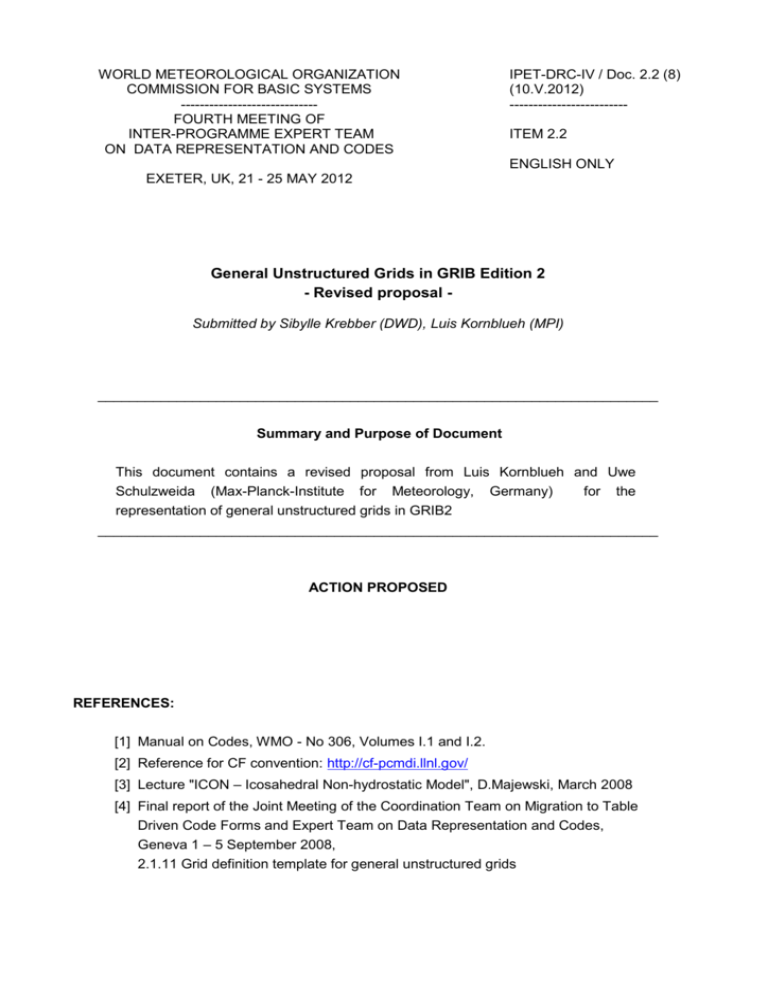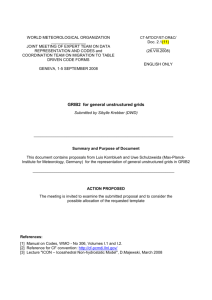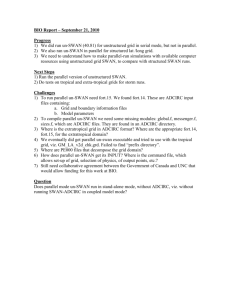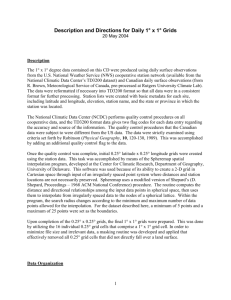General Unstructured Grid in Grib Edition 2
advertisement

WORLD METEOROLOGICAL ORGANIZATION COMMISSION FOR BASIC SYSTEMS ----------------------------FOURTH MEETING OF INTER-PROGRAMME EXPERT TEAM ON DATA REPRESENTATION AND CODES IPET-DRC-IV / Doc. 2.2 (8) (10.V.2012) ------------------------ITEM 2.2 ENGLISH ONLY EXETER, UK, 21 - 25 MAY 2012 General Unstructured Grids in GRIB Edition 2 - Revised proposal Submitted by Sibylle Krebber (DWD), Luis Kornblueh (MPI) _______________________________________________________________________ Summary and Purpose of Document This document contains a revised proposal from Luis Kornblueh and Uwe Schulzweida (Max-Planck-Institute for Meteorology, Germany) for the representation of general unstructured grids in GRIB2 _______________________________________________________________________ ACTION PROPOSED REFERENCES: [1] Manual on Codes, WMO - No 306, Volumes I.1 and I.2. [2] Reference for CF convention: http://cf-pcmdi.llnl.gov/ [3] Lecture "ICON – Icosahedral Non-hydrostatic Model", D.Majewski, March 2008 [4] Final report of the Joint Meeting of the Coordination Team on Migration to Table Driven Code Forms and Expert Team on Data Representation and Codes, Geneva 1 – 5 September 2008, 2.1.11 Grid definition template for general unstructured grids DISCUSSIONS Currently models with fully unstructured grids are in development in a joint effort between Deutscher Wetterdienst (DWD) and the Max Planck Institute for Meteorology. The grid description is rather large and requires 8 byte IEEE floating-point numbers for sufficient precision for high resolution models. The overhead in saving those in a GRIB record would contradict the most important property which is small size. As well the variety of grids possible would make it difficult to define a simple description. So we propose to reference the grid description in section 3. The referenced files should be made available by the centre given in section 1. We propose to use the CF convention for describing the unstructured grid, which has been developed in a large international effort with the climate modelling community. This convention develops currently to the de-facto standard. In 2008 a new template was proposed and approved for validation. During the validation process an additional Universal Unique Identifier UUID has been introduced, because it cannot be assured that the centre and local identifier are sufficiently accessible and are maintained properly in the context of climate modelling usage. UUIDs are documented as part of ISO/IEC 11578:1996 "Information technology – Open Systems Interconnection – Remote Procedure Call (RPC)" and more recently in ITU-T Rec. X.667 | ISO/IEC 9834-8:2005. The IETF has published Standards Track RFC 4122 that is technically equivalent with ITU-T Rec. X.667 | ISO/IEC 9834-8. REVISED PROPOSAL Grid Definition Template 3.101 General Unstructured Grid Octet No. 15 16-18 19 20-35 Contents Shape of the Earth (see Code Table 3.2) Number of grid used (defined by originating centre) Number of grid in reference (to allow annotating for Arakawa C-grid on arbitrary grid) (Note 1) UUID of horizontal grid Notes: (1) The Number is associated with an attribute of the respective grid description which consists of the centre longitude/latitude and the longitude/latitude of the boundary polygon vertices. Variables can be defined on different positions an the triangle. This leads to different sets of geo locations, e.g.: 1. triangles (i) (pressure, temperature,..) 2. quads (l) (wind velocity ..) 3. hexagons respectively pentagons (v) (vorticity)











